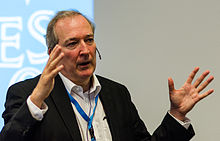Stéphane Udry
Stéphane Udry | |
|---|---|
 | |
| Born | 1961 |
| Nationality | Swiss |
| Occupation | Astronomer |
Stéphane Udry (born 1961 in Sion, Switzerland) is an astronomer at the Geneva Observatory in Switzerland, whose current work is primarily the search for extra-solar planets. He and his team, in 2007, discovered a possibly terrestrial planet in the habitable zone of the Gliese 581 planetary system, approximately 20 light years away in the constellation Libra.[1][2][3] He also led the observational team that discovered HD 85512 b, another most promisingly habitable exoplanet. [4]
Career
Udry earned a doctorate at the University of Geneva in 1992, and spent two years at Rutgers University in New Jersey. Later, Udry returned to Geneva, and worked with Michel Mayor, the discoverer of 51 Pegasi b, the first extrasolar planet found revolving around a normal star. In 2007, Udry was appointed full professor in the faculty of natural sciences at the University of Geneva.
Research
Udry's initial research concerned the dynamics of galaxies. His current work chiefly concerns the search for extra-solar planets by analyzing variations in the radial velocities of stars. Among them was Gliese 581c (announced April 25, 2007) which at the time, was the most likely candidate for habitability of any extrasolar planet discovered so far. The planet was discovered by analyzing data obtained by the High Accuracy Radial Velocity Planet Searcher (HARPS) on the European Southern Observatory's 3.6 meter telescope at La Silla Observatory in Chile.
He was interviewed by Mat Kaplan on Planetary Radio. Udry described a new instrument known as the Echelle Spectrography for Rocky Exoplanet and Stable Spectroscopic Observations, dubbed ESPRESSO, might allow astronomers to detect Earth-like planets within five to ten years from 2010.[5]
An upgraded HARPS, of which Udry lead the observational team, found evidence that Gliese 581d might be more habitable (rather than c or g), and also detected another promising candidate: HD 85512 b.[4]
See also
References
- ^ Dennis Overbye (April 25, 2007). "20 light years away, the most Earthlike planet yet". The New York Times. Retrieved 2010-12-22.
The most enticing property yet found outside our solar system is about 20 light years away in the constellation Libra, according to a team of European astronomers. The astronomers said Tuesday that they had discovered a planet five times as massive as the Earth orbiting a dim red star known as Gliese 581. It is the smallest of the 200 or so planets that are known to exist outside of our solar system, the extrasolar, or exo-, planets. It orbits its home star within the so-called habitable zone where surface water, the staff of life, could exist if other conditions are right, said Stéphane Udry of the Geneva Observatory.
- ^ JOHN NOBLE WILFORD (June 19, 2002). "Another Cousin to Jupiter Is Found". The New York Times. Retrieved 2010-12-22.
Dr. Stéphane Udry, a member of the team from the Geneva Observatory in Switzerland, said in an interview that what was missing in this planetary system — mammoth planets extremely close to the host stars — made it a more promising solar system analog than the one announced last week by the leading team of American planet hunters. The star the Americans found is accompanied by one and probably two Jupiter-size planets at closer distances than Mercury is from the Sun.
- ^ Jeremy Manier (April 25, 2007). "Just like home, yet light years from Earth". Chicago Tribune. Retrieved 2010-12-22.
As with nearly all such planetary discoveries, astronomers could not observe Gliese 581 directly because it is invisible in the glare of its sun. Instead, the European group led by Stephane Udry and Michael Mayor calculated the planet's presence from its tiny gravitational tug on the star.
- ^ a b "Fifty New Exoplanets Discovered by HARPS". ESO. 12 September 2011. Retrieved 2011-11-13.
- ^ Joel Achenbach (October 20, 2009). "Newly found 'exoplanets' are out of this world". Washington Post. Retrieved 2010-12-22.
Astronomer Stéphane Udry of Geneva University said by e-mail that a new instrument under development, known as ESPRESSO (Echelle Spectrograph for Rocky Exoplanet- and Stable Spectroscopic Observations), "should allow us to detect Earth twins around solar-type stars, within 5 to 10 years." "Personally, I am convinced that planets are everywhere," Udry said. "Nature does not like void."
